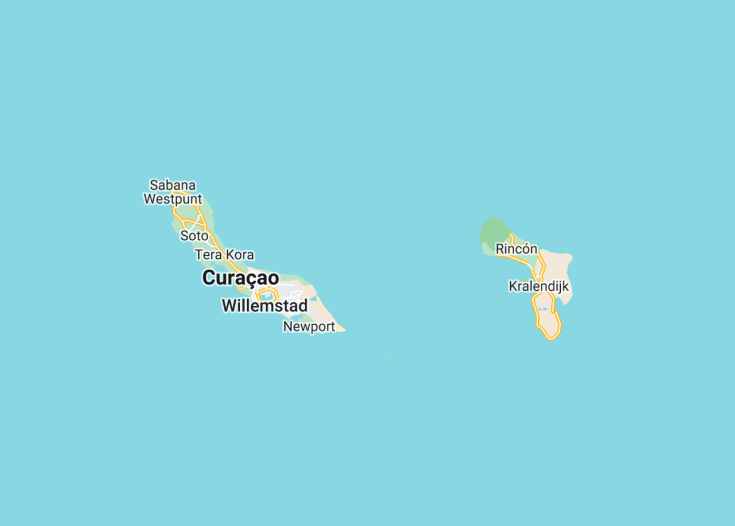Netherlands Antilles, also known as the Dutch Caribbean, is a captivating destination in the Caribbean Sea. With its stunning beaches, vibrant culture, and rich history, it offers a unique experience for travelers. Discover breathtaking coral reefs and underwater biodiversity while snorkeling or diving. Explore the charming streets of Willemstad, a UNESCO World Heritage site, with its colorful Dutch colonial buildings and vibrant street art. Immerse yourself in the diverse culture and savor the mouthwatering cuisine that blends Caribbean, European, and Latin American flavors.
Experience the exhilarating Carnival celebrations, filled with vibrant parades, music, and dancing.
Don’t miss the chance to visit Klein Curaçao, a small uninhabited island known for its pristine beaches and crystal-clear waters.
Top destinations in Netherlands Antilles (Netherlands)
Netherlands Antilles: a Caribbean mosaic
| Status | Dissolved |
| Capital | Willemstad |
| Time in Netherlands Antilles | GMT -4 |
| Language spoken | Dutch, Papiamento, English |
| Population | Note: The Netherlands Antilles was officially dissolved in 2010. Population data prior to that year was approximately 227,000 (source: UNdata, 2009). |
| Religion | Christianity (Catholicism and Protestantism combined) (85%) Other Religions (10%) Non-religious (5%) |
| Currency | Netherlands Antillean guilder (ƒ, ANG) |
| Airports | Princess Juliana International Airport Curaçao International Airport Flamingo International Airport |
The Netherlands Antilles, a name reminiscent of the Caribbean’s colonial past, once referred to a series of islands under Dutch sovereignty that painted a tropical picture of pristine beaches and vibrant cultures. Established in the mid-20th century, this political entity was a constellation of several islands, each boasting a unique character and shared history under the Dutch flag.
Originating from the Age of Discovery, these islands became a haven for European powers seeking strategic locations for trade and influence. Over the centuries, the Netherlands cemented its dominion over this archipelago, establishing a blend of European and Caribbean traditions. This fusion is most evident in the island’s architectural designs, with Dutch colonial buildings colored in bright Caribbean hues.
However, the story of the Netherlands Antilles took a turn in 2010, when it was officially dissolved. The islands took different paths: Curaçao and Sint Maarten became autonomous countries within the Kingdom of the Netherlands, while Bonaire, Sint Eustatius, and Saba became special municipalities of the Netherlands itself. This restructuring, while administrative, did little to dampen the vibrant spirit of these islands, and they continue to be a beacon for travelers seeking a mix of European elegance and Caribbean flair.
Where was Netherlands Antilles located?
The Netherlands Antilles was an archipelago situated in the Caribbean Sea. It comprised several islands, notably Curaçao and Sint Maarten, located to the north of Venezuela and east of Puerto Rico.
What was Netherlands Antilles famous for?
The Netherlands Antilles was famed for its stunning beaches, Dutch colonial architecture, and rich cultural fusion. The islands were also known for their festivals, diving spots, and historic forts.
History
Pre-European Era: Early Inhabitants
The history of the Netherlands Antilles traces back to several Amerindian tribes, such as the Caiquetios, Arawaks, and Caribs, who initially settled the islands. These early inhabitants led nomadic lifestyles and were skilled at fishing and agriculture. The Arawaks, in particular, are known for their peaceful nature and intricate pottery.
1499-17th Century: Spanish and Dutch Colonization
Spanish explorers, led by Alonso de Ojeda, discovered and claimed the islands in 1499. Initially named Las Islas Inutiles (Useless Islands) due to their perceived lack of gold and other valuable resources, they remained largely neglected by the Spanish Crown. However, in the early 17th century, the Dutch West India Company took control, recognizing the islands’ strategic importance for trade and as a buffer against other European powers. The Dutch established settlements, brought in African slaves, and started cultivating cash crops like sugarcane.
17th Century to 19th Century: Economic Growth and Transitions
Under Dutch rule, the islands experienced significant economic growth, particularly with the establishment of sugarcane plantations. Slavery became a backbone of this economic system until its abolition in 1863. Following the abolition, the islands underwent a period of economic transition, gradually moving from agriculture-based economies to ones more focused on trade, shipping, and other maritime activities.
20th Century: Formation of the Netherlands Antilles
In the 1950s, as decolonization movements swept across the globe, the islands of the Netherlands Antilles were granted autonomy within the Kingdom of the Netherlands. In 1954, the Charter for the Kingdom of the Netherlands formally established the Netherlands Antilles as an autonomous Caribbean country within the kingdom, consisting of several islands, including Curaçao, Bonaire, Saba, Sint Eustatius, and Sint Maarten.
Late 20th Century to Early 21st Century: Dissolution and Reconfiguration
Throughout the latter half of the 20th century, there were growing internal debates about the configuration of the Netherlands Antilles. Some islands sought closer ties with the Netherlands, while others preferred greater autonomy or even independence. After a series of referenda and negotiations, it was decided to dissolve the Netherlands Antilles. In 2010, this dissolution took effect: Curaçao and Sint Maarten became autonomous countries within the Kingdom of the Netherlands, while Bonaire, Saba, and Sint Eustatius became special municipalities of the Netherlands. This reconfiguration marked the end of the Netherlands Antilles as a political entity.










